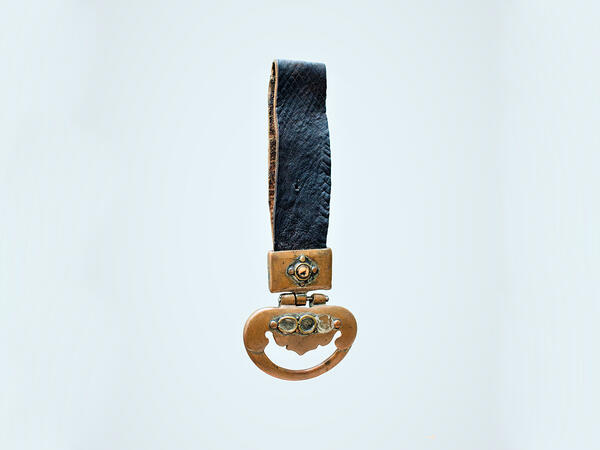The Tuvan custom to wear figured buckles on the belt pendant — dergi — has its roots in the ancient Turkic traditions of the second half of the I millennium A.D. Since most Tuvan ornaments and accessories were suspended from a belt, a common name for them was allocated — kur kaastalgalary, which means ‘belt ornaments’.
Wealthy men usually wore two silver or bronze cast decorated buckles. They were fastened to the belt with a belt loop. This structure was called a dergi.
Men’s buckles consisted of two halves connected by hinges. The upper one was fastened to a belt with a loop through which the belt was threaded. The lower half could be used to hang a flint, a knife in a scabbard, a metal cup into which tobacco ash was dumped, or a sickle-shaped hook to clean the smoking pipe of soot. Sometimes a tun shell, a shaman attribute for summoning spirits, was fastened to the buckle.
In spite of the fact that dergi were considered the main accessory of men’s costumes, women also wore them from time to time. They mostly wore the buckles as decoration. Sometimes silk tassels were tied to the dergi.
Side belt buckles to which objects of everyday use were attached were known to the early nomads and have survived in the culture of a number of pastoral peoples. The shape of these plaques changed over time.
In Scythian times, they had a rectangular shape. Objects were fastened to the buckle with a strap — at the bottom, there was a special slot for it. In the late nineteenth and early twentieth centuries, Tuvan blacksmiths cast dergi from silver, copper, or iron using a special wooden model. Plaques of wood or bone were sometimes found.
Since the nineteenth century, Tuvans have mostly purchased metal, but in previous centuries they mined the ore themselves. There were many skilled blacksmiths among them. In small clay furnaces — khura — up to the 18th century Tuvans smelted iron using their own technology.
The mined ore was ground in mortars, mixed with coal, and poured in small portions into the upper opening of the furnace. Two bellows were used to press the air, maintaining a constant burning temperature. About one and a half kilograms of iron was obtained from a single smelting, from which artisans made knives, items for cattle and farming, and jewelers made jewelry. Tuvan jewelers highly valued silverware. Silver was used to create flintstones, earrings, rings, buckles, and more. Pipes and tobacco pouches were also often inlaid with silver or pewter.
Dergi were decorated with a variety of ornaments. The most popular were types of knots, combinations of horn-like patterns, plant motifs and images of animals. In addition to complex compositions, dergi were also painted with simple geometric patterns.
Wealthy men usually wore two silver or bronze cast decorated buckles. They were fastened to the belt with a belt loop. This structure was called a dergi.
Men’s buckles consisted of two halves connected by hinges. The upper one was fastened to a belt with a loop through which the belt was threaded. The lower half could be used to hang a flint, a knife in a scabbard, a metal cup into which tobacco ash was dumped, or a sickle-shaped hook to clean the smoking pipe of soot. Sometimes a tun shell, a shaman attribute for summoning spirits, was fastened to the buckle.
In spite of the fact that dergi were considered the main accessory of men’s costumes, women also wore them from time to time. They mostly wore the buckles as decoration. Sometimes silk tassels were tied to the dergi.
Side belt buckles to which objects of everyday use were attached were known to the early nomads and have survived in the culture of a number of pastoral peoples. The shape of these plaques changed over time.
In Scythian times, they had a rectangular shape. Objects were fastened to the buckle with a strap — at the bottom, there was a special slot for it. In the late nineteenth and early twentieth centuries, Tuvan blacksmiths cast dergi from silver, copper, or iron using a special wooden model. Plaques of wood or bone were sometimes found.
Since the nineteenth century, Tuvans have mostly purchased metal, but in previous centuries they mined the ore themselves. There were many skilled blacksmiths among them. In small clay furnaces — khura — up to the 18th century Tuvans smelted iron using their own technology.
The mined ore was ground in mortars, mixed with coal, and poured in small portions into the upper opening of the furnace. Two bellows were used to press the air, maintaining a constant burning temperature. About one and a half kilograms of iron was obtained from a single smelting, from which artisans made knives, items for cattle and farming, and jewelers made jewelry. Tuvan jewelers highly valued silverware. Silver was used to create flintstones, earrings, rings, buckles, and more. Pipes and tobacco pouches were also often inlaid with silver or pewter.
Dergi were decorated with a variety of ornaments. The most popular were types of knots, combinations of horn-like patterns, plant motifs and images of animals. In addition to complex compositions, dergi were also painted with simple geometric patterns.



